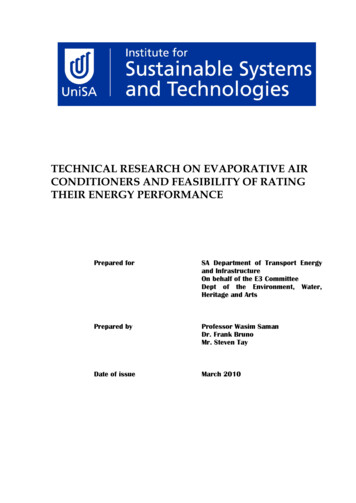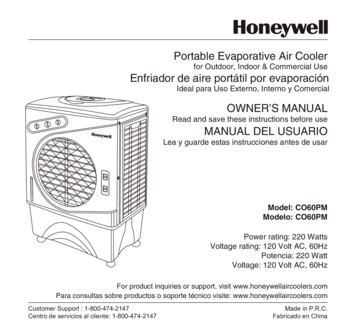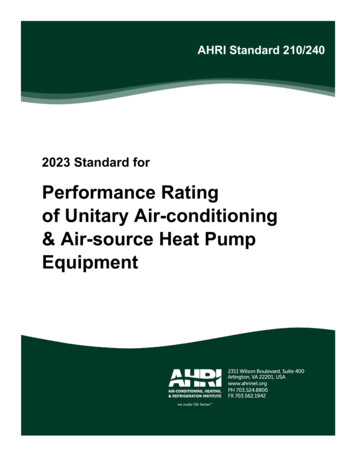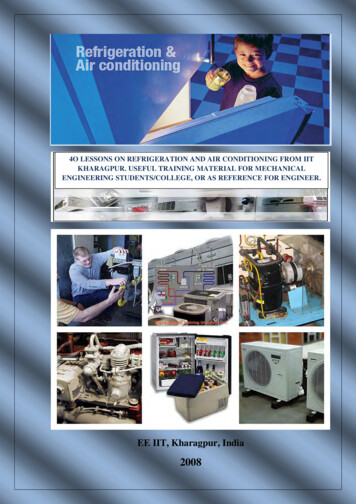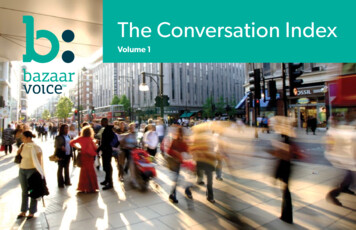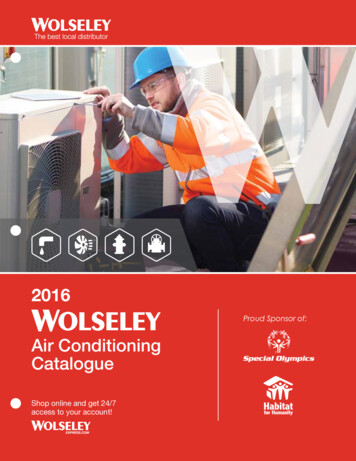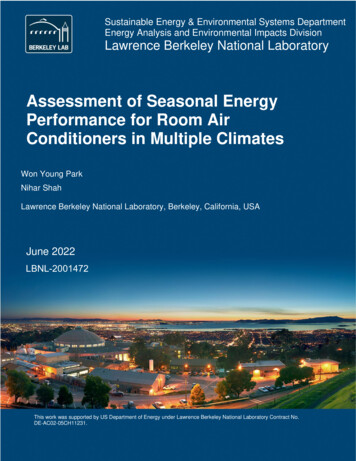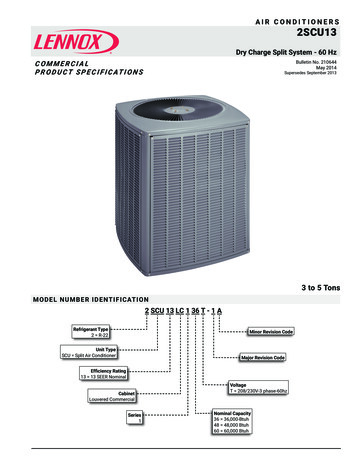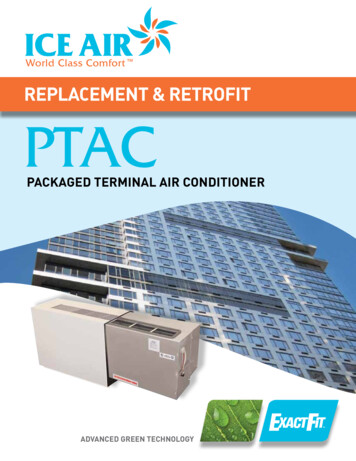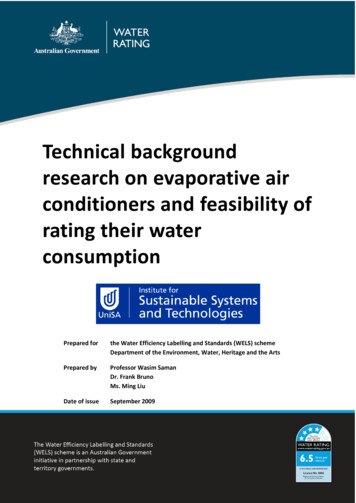
Transcription
Technical backgroundresearch on evaporative airconditioners and feasibility ofrating their waterconsumptionPrepared forthe Water Efficiency Labelling and Standards (WELS) schemeDepartment of the Environment, Water, Heritage and the ArtsPrepared byProfessor Wasim SamanDr. Frank BrunoMs. Ming LiuDate of issueSeptember 2009
Technical background research on evaporative air conditioners and feasibility of rating their waterconsumption Commonwealth of Australia 2017First published by the Department of the Environment, Water, Heritage and the Arts in 2009.Ownership of intellectual property rightsUnless otherwise noted, copyright (and any other intellectual property rights, if any) in this publication is owned by theCommonwealth of Australia (referred to as the Commonwealth).Creative Commons licenceAll material in this publication is licensed under a Creative Commons Attribution 4.0 International Licence except contentsupplied by third parties, logos and the Commonwealth Coat of Arms.Inquiries about the licence and any use of this document should be emailed to copyright@agriculture.gov.au.Cataloguing dataThis publication (and any material sourced from it) should be attributed as: Water Efficiency Labelling and StandardsRegulator 2009, Technical background research on evaporative air conditioners and feasibility of rating their waterconsumption, Department of the Environment, Water, Heritage and the Arts, Canberra, September. CC BY 4.0.This publication is available at ir-water-consumption.Water Efficiency Labelling and Standards RegulatorWater Efficiency Labelling and Standards schemeDepartment of Agriculture and Water ResourcesPostal address GPO Box 858 Canberra ACT 2601Telephone 1800 372 746 (local calls) 61 2 6272 5232 (international)Email wels@agriculture.gov.auWeb agriculture.gov.auThe Australian Government acting through the Department of Agriculture and Water Resources has exercised due care andskill in preparing and compiling the information and data in this publication. Notwithstanding, the Department ofAgriculture and Water Resources, its employees and advisers disclaim all liability, including liability for negligence and forany loss, damage, injury, expense or cost incurred by any person as a result of accessing, using or relying on any of theinformation or data in this publication to the maximum extent permitted by law.Department of Agriculture and Water Resourcesi
Technical background research on evaporative air conditioners and feasibility of rating their waterconsumptionContentsExecutive summary . 11234Background information . 31.1Types of evaporative air conditioners . 31.2Suitability for use in Australia. 81.3Market share of evaporative air conditioners. 91.4Water consumption of evaporative air conditioners . 101.4.1Water evaporation . 111.4.2Water bleeding/dumping system . 131.4.3Total water consumption . 141.5Cooling pads . 151.6Effect of water quality . 16Review of available regulations and standards .182.1Australian standards. 182.2International regulations and standards . 182.3Merits of inclusion in the WaterMark certification scheme . 21Testing to evaluate water consumption .223.1Development of a test methodology for rating water consumption . 223.2Development of a procedure for rating/labelling water consumption. 23Conclusions and recommendations.25References .27Appendix 1: Available evaporative air conditioners in Australia and their key specifications .30Appendix 2: Raw air conditioner data in Figures 2 and 3 (ABS data) .46Appendix 3: Evaporated water consumption in a typical hot day .48Appendix 4: Evaporated water consumption in a typical summer day .51Appendix 5: Tap water quality in Adelaide, Sydney and Melbourne .54Appendix 6: Industry contact list.57TablesTable 1: Temperature (dry bulb) and relative humidity (RH) levels for some Australian locations usingdirect and 2 stage cooling systems . 8Table 2: Evaporated water consumption rate for different unit sizes and Australia locations . 12Table 3: Evaporated water consumption in typical days in Adelaide** . 13Table 4: Energy Efficiency Thresholds for Iranian Energy Label (Iran Energy Efficiency Organisation) 20Department of Agriculture and Water Resourcesii
Technical background research on evaporative air conditioners and feasibility of rating their waterconsumptionTable A5.1: Tap water quality in 2007-08 metropolitan Adelaide distribution systems (SA Water,2008). 54Table A5.2: Tap water quality in 2008 Sydney distribution systems (Sydney Water, 2009) . 55Table A5.3: Tap water quality in 2007-08 City West Water distribution systems in Melbourne (CityWest Water Ltd, 2008) . 56FiguresFigure 1: Types of evaporative air conditioners: (a) direct; (b) indirect & (c) two-stage combined(Wang et al., 2000) . 4Figure 2: Schematic diagram of the components of a typical direct evaporative cooler . 6Figure 3: Portable evaporative air conditioners. 7Figure 4: (a) Window evaporative air conditioner; (b) View from cooled space; (c) View from outside 7Figure 5: Residential roof ducted evaporative air conditioners with different profiles . 8Figure 6: National penetration and number of air conditioners (ABS, 2008) . 9Figure 7: Share of all installed stock of domestic air conditioners which are of the evaporative variety,by state and nationally (ABS, 2008) . 10Figure 8: Psychrometrics of direct evaporative cooling . 11Figure 9: Two types of cooling pads. (a) Aspen wood pads & (b) Celdek pads (CELdek 7060-15manufactured by Munters Pty Ltd) . 15Figure 10: Example of the Iranian energy label (Iran Energy Efficiency Organisation) . 21Figure 11: Schematic diagram of the proposed test rig . 23Department of Agriculture and Water Resourcesiii
Technical background research on evaporative air conditioners and feasibility of rating their waterconsumptionExecutive summaryThe installation of mechanical air conditioning appliances is gradually becoming a normalrequirement in almost all new and existing Australian dwellings. While the use of refrigerated airconditioners have been rapidly increasing, the market share of evaporative air conditioners haswitnessed a steady decline and currently makes up less than 20% of the installed systems inAustralian dwellings. Domestic air conditioning has considerable impact on energy use and peakpower demand. Evaporative air conditioners consume less energy but require water for theiroperation.This report provides technical background material to inform the possible inclusion of evaporative airconditioners in the WELS Scheme with the aim of informing consumers on their water consumption.The report describes current and future evaporative air conditioner designs, principle of operationand main components. It lists and reviews the specifications of available models in the Australianmarket, which is dominated by four major Australian manufacturers. It also provides information onthe suitability of evaporative cooling in major Australian geographical locations.The water consumption of evaporative air conditioners includes the water evaporated to provide thecooling effect and the water dumped off for the purpose of cleaning and avoiding high saltconcentration. The amount of water evaporation is determined by the local temperature andhumidity, the air delivery rate as well as the saturation effectiveness. The cooling pad materialscommonly in use are Aspen wood and more commonly Celdek. The amount of water dumped off isdependent on the bleeding/dumping method used and the quality of incoming water. The reportreviews three bleeding/dumping systems employed, namely: constant bleed off; salinity levelmonitoring; and periodic/timed drain off systems. The report discusses the bleed off rates and thefrequency of draining of the bleeding systems and also discusses different water qualities acrossAustralia and their effect on water consumption and product maintenance.The report includes available information on water consumption of evaporative air conditioners andcalculations of amounts necessary for water evaporation in different Australian locations. Onaverage, evaporative air conditioners consume 2-9% (approximately 4-18 kilolitres per annum) of thetotal annual water used in typical Australian households and the amount of water consumption ismainly dependent on the water evaporated for cooling purposes.This report also reviews currently available local and international regulations and standards fortesting, labelling and rating evaporative air conditioners. However, none were found that measuredtheir water consumption. The report demonstrates that it is possible to test and rate evaporative airconditioners for water efficiency. A proposed test and evaluation methodology for rating waterconsumption is put forward. It is proposed that independent testing should be carried out alongsideenergy consumption testing using a single test facility.The test requirements and conditions follow current Australian Standards AS/NZS 2913-2000 Evaporative air conditioning equipment and require additional facilities to simulate standard outdoordesign conditions, measure incoming water quality and monitor in-situ water consumption. Threekey parameters will be evaluated from testing and subsequent computer modeling including (1) totalwater consumption per hour at design conditions; (2) total annual water consumption and (3) waterDepartment of Agriculture and Water Resources1
Technical background research on evaporative air conditioners and feasibility of rating their waterconsumptiondumping rate per kg of cooled air. The last parameter is considered most appropriate for WELSlabeling purposes.The report confirms the suitability of including evaporative air conditioners into the WELS Scheme.However, in view of the relationship between water and energy consumption of evaporative airconditioners, it is recommended that performance rating/labelling of both water and energy shouldbe introduced simultaneously.Early consultation with manufacturers, suppliers and users groups is considered to be an importantstep in progressing a labelling/rating system for energy and water use in evaporative air conditioners.A technical study for developing a standard test procedure, testing facilities and methodology forindependent testing, rating/labelling of both water and energy use in evaporative air conditioners, aswell as modifying the current testing standard to provide for this, is also recommended.Department of Agriculture and Water Resources2
Technical background research on evaporative air conditioners and feasibility of rating their waterconsumption1 Background information1.1Types of evaporative air conditionersThe utilisation of water evaporation for cooling purposes has its origins well entrenched in history.Evidence of evaporative cooling applications by ancient people of the Middle East is widelydocumented and some of these applications are still in use in the Middle East today. They include theuse of porous water vessels, the wetting of pads made of dried vegetables which cover the doors andwindows facing the prevailing wind and directing the prevailing wind into pools of running water inunderground rooms (Saman, 1993). Early Australians also used different forms of evaporative aircooling to obtain some comfort in the hot dry climates of outback Australia.Direct evaporative air conditioning is ideal for arid climates where water is available. The directevaporative air conditioners currently produced have, by and large, overcome the drawbacksassociated with older systems. In addition to more efficient fan and duct designs and controlsystems, the use of plastics for the bodywork and cellulose and other synthetic materials for the padstogether with automatic water bleeding or flushing has resulted in more reliable operation with littlemaintenance. Many of today’s evaporative air conditioners have quite sophisticated control systemswith variable air speeds and pad wetting rates. The one remaining drawback associated with directcooling is the water saturation limit inherent in the process. Even with saturation efficiency over80%, which is common for many modern systems, the air supplied may not provide cooling comfort ifthe outside air temperature is high and/or its moisture content is high and close to saturation withwater vapour. The lowest possible temperature limit attained by direct evaporative cooling is the wetbulb temperature at which the delivered air is fully saturated with moisture.Evaporative air conditioners can be categorised as direct, indirect and two- and multi-stage. Directevaporative air conditioners are the most popular in the market. As shown in Fig.1 (a), outside air isdrawn through wetted filter pads, where the hot dry air is cooled and humidified through waterevaporation. The evaporation of water takes some heat away from the air making it cooler and morehumid. The dry-bulb temperature of the air leaving the wetted pads approaches the wet-bulbtemperature of the ambient air. Direct evaporative air conditioners are more effective in dryclimates. As they produce warmer, more humid air in comparison with refrigerated air conditioners,considerably more air volumes are required to produce the same cooling effect. The cool/humid air isused once and cannot be reused. Evaporation (saturation) effectiveness is the key factor indetermining the performance of evaporative air conditioners. It is defined by Eqn.1. This propertydetermines how close the air being conditioned is to the state of saturation. Usually, theeffectiveness is 85-95% (ASHRAE Handbook, 2007). e 100t1 t 2t1 t '(1)Where e direct evaporation (saturation) effectiveness, %t1 dry-bulb temperature of entering air, oCDepartment of Agriculture and Water Resources3
Technical background research on evaporative air conditioners and feasibility of rating their waterconsumptiont2 dry-bulb temperature of leaving air, oCt' wet-bulb temperature of entering air, oCFigure 1: Types of evaporative air conditioners: (a) direct; (b) indirect & (c) two-stagecombined (Wang et al., 2000)FANFANFANThe saturation effectiveness also has an impact on water consumption. Increased saturationeffectiveness is associated with higher water consumption. However, as higher saturationeffectiveness produces conditioned air at lower temperatures, the overall impact of having highersaturation effectiveness is usually an improved energy and water consumption per unit coolingoutput.Indirect evaporative air cooling is shown in Fig.1(b). The principle of operation of indirect evaporativecooling is the use of cool air produced by direct evaporative cooling (secondary air stream shown inFig. 1(b)) to cool the air stream which is used for space cooling by the use of a heat exchanger. Ascooling of the primary air stream takes place by heat transfer across the heat exchanger wallswithout the mixing of the 2 air streams, the primary air stream becomes cooler without an increasein its humidity. Indirect evaporative air conditioners are effective in regions with moderate/highhumidity. Indirect evaporative cooling effectiveness is defined in Eqn.2. According to manufacturers’rating, this effectiveness ranges from 40 to 80% (ASHRAE Handbook, 2004). ie 100Department of Agriculture and Water Resourcest1 t 2t 1 t s'(2)4
Technical background research on evaporative air conditioners and feasibility of rating their waterconsumptionWhere ie indirect evaporative cooling effectiveness, %t1 dry-bulb temperature of entering primary air, oCt2 dry-bulb temperature of leaving primary air, oCt's wet-bulb temperature of entering secondary air, oCTwo stage or indirect/direct evaporative air conditioners combine both direct and indirectevaporative principles. In two-stage evaporative air conditioners, the first stage (indirect) sensiblycools the primary air (without increasing its moisture content) and the air is evaporatively cooledfurther in the second stage (direct) as shown in Fig.1(c). The dry-bulb temperature of the suppliedprimary air can be reduced to 6 K or more below the secondary air wet-bulb temperature (ASHRAEHandbook, 2004) without adding too much moisture. As two-stage evaporative air conditionersproduce lower temperatures, they consequently require less air delivery in comparison with thedirect systems. Heidarinejad et al. (2009) experimentally studied the cooling performance of twostage evaporative cooling systems under the climate conditions of seven Iranian cities. It has beenfound that the saturation effectiveness (as defined in equation 1) of the indirect/direct evaporativeair conditioner varies in a range of 108 111%. Also, over 60% energy can be saved using this systemcompared to a vapour compression system. However, it consumes 55% more water in comparisonwith direct evaporative cooling system for the same air delivery rate. Monitoring the electricityconsumption of evaporative and conventional refrigerated cooling systems in a small commercialbuilding has demonstrated considerable energy savings and improved thermal comfort withevaporative cooling (Saman, et al. 1995). Indirect evaporative cooling can also be used as acomponent of multistage air conditioning systems which also include refrigerated cooling stages. Insuch cases, the indirect evaporative cooling may be sufficient for the provision of typical summercooling requirements. The refrigerated stage operation is limited to peak demand days.The main focus of this report is direct evaporative air conditioners as most units in current use withinAustralia are of this variety. However, the scope of the report also includes indirect and two-stagesystems in view of their anticipated entry into the Australian market.A direct evaporative air conditioner is an enclosed metal or plastic box with louvers on the sidescontaining a fan or a blower with an electric motor, a number of cooling pads, a water circulationpump to wet the cooling pads and a float valve to maintain a proper water level in the reservoir. Fig.2 illustrates the components in a typical evaporative cooler.Department of Agriculture and Water Resources5
Technical background research on evaporative air conditioners and feasibility of rating their waterconsumptionFigure 2: Schematic diagram of the components of a typical direct evaporative coolerTypes of evaporative air conditioners range from portable units, window/wall units and ducted unitsfor residential and commercial use. Portable units cool one room at a time. They are fitted with legsand wheels and can be moved easily from room to room. A small pump is utilised to keep the coolingpads wet and water is needed to be periodically filled manually in the internal water storage tank.Typical portable evaporative air conditioners are shown in Fig.3. However, this report only examinesplumbed units/systems and therefore the portable units will be excluded from the discussion.Window/wall evaporative air conditioners are mounted through exterior windows or walls and theycan cool larger areas than portable units. A window evaporative unit is presented in Fig. 4. Ductedevaporative air conditioners make up the vast majority in use in Australia. They are usually mountedon the roof and the cooled air is delivered through ducts to each room in the building. Fig. 5 showsresidential roof ducted evaporative air conditioners with different profiles. Both window/wall andducted units have water bleeding systems to control the water salinity under a certain level.Department of Agriculture and Water Resources6
Technical background research on evaporative air conditioners and feasibility of rating their waterconsumptionFigure 3: Portable evaporative air peac/ConvairPEAC.html)Figure 4: (a) Window evaporative air conditioner; (b) View from cooled space; (c) Viewfrom ng/window/default.aspx)Department of Agriculture and Water Resources7
Technical background research on evaporative air conditioners and feasibility of rating their waterconsumptionFigure 5: Residential roof ducted evaporative air conditioners with different profiles1.2Suitability for use in AustraliaTable 1 includes an estimate of the expected dry and wet bulb temperatures for 13 Australianlocations at the summer design conditions. Comfort expectation can be found by using the comfortchart. The table shows that comfort is achievable only in regions having relatively cool and/or drysummers (marked in green) with the conditions of all other locations falling outside the comfort zone(marked in red) (Saman, 1993, Saman, 1994).Table 1: Temperature (dry bulb) and relative humidity (RH) levels for some Australianlocations using direct and 2 stage cooling systemsLocationSummerDesignConditionsdry bulb CSummerDesignConditionswet bulb CDirectdry bulb CDirectRH%2 stagedry bulb C2 stageRH%Adelaide SA36.021.027.8 (green)62% (green)23.9 (green)67% (green)Albury NSW39.024.030.8 (red)63% (red)27.2 (green)68% (green)Alice Springs NT39.523.530.5 (red)62% (red)26.5 (green)68% (green)Anna Plains WA41.029.036.0 (red)64% (red)32.6 (red)75% (red)Brisbane QLD31.025.029.5 (red)75% (red)28.0 (red)81% (red)Canberra ACT34.021.027.3 (green)64% (green)23.9 (green)54% (green)Cloncurry QLD41.025.532.4 (red)63% (red)28.8 (red)70% (red)Darwin NT34.528.533.0 (red)76% (red)31.6 (red)80% (red)Melbourne VIC34.521.027.4 (green)63% (green)23.9 (green)70% (green)Mildura VIC38.023.530.1 (red)64% (red)26.6 (green)70% (green)Perth WA36.024.030.0 (red)67% (red)27.2 (green)72% (green)Sydney NSW30.523.027.9 (green)65% (green)26.1 (green)75% (green)Woomera SA39.522.029.4 (red)58% (red)25.0 (green)66% (green)One option for extending the climatic regions where evaporative cooling is effective is the use of 2stage indirect/direct evaporative cooling. The use of a heat exchanger to cool the outside air withouthumidifying it by making use of indirect evaporative cooling systems was developed in Australia inthe 1960s and 1970s; plate heat exchangers were manufactured and marketed (Pescod, 1968 &Pescod, 1979). From the manufacturing view point, the main challenge of the system is the size andcost of the heat exchanger required to achieve good effectiveness and low pressure loss. Work hasbeen undertaken in Adelaide, Australia to develop low cost heat exchangers optimised for heatrecovery as well as indirect evaporative cooling purposes (Saman & Kilsby, 1999).Department of Agriculture and Water Resources8
Technical background research on evaporative air conditioners and feasibility of rating their waterconsumptionHaving indirectly cooled the outside air, its wet bulb temperature also drops. This makes the secondstage of direct evaporative cooling more effective and enables the provision of thermal comfort forthe occupants in many additional Australian locations as seen in Table 1. It is evident that occupants’thermal comfort is improved when using the two stage system in comparison with the direct orindirect system alone. Most locations in Australia, except the humid tropical regions, achieve comfortconditions with two-stage systems.1.3Market share of evaporative air conditionersThere are currently four major local evaporative air conditioner manufacturers: Air Group AustraliaPty Ltd, Carrier Australia Pty Ltd, Climate Technologies Pty Ltd and Seeley International Pty Ltd. Theevaporative air conditioners that are currently available in Australia together with their key availablespecifications (such as type, energy input, water bleeding system, fan and pad type, supply flow rate,control system and evaporation efficiency) are listed in Appendix 1.Fig. 6 shows the national penetration of air conditioners and the number of air conditioners(including refrigerated and evaporative) utilised in residential houses in Australia from 1994 to 2008(ABS, 2008). Penetration is the proportion of households having a particular type of air conditioner.The refrigerated air conditioners refer to the reverse cycle and cooling only refrigerated airconditioners, non-ducted or ducted. Between 1999 and 2008, there has been a sharp increase inpenetration and the number of refrigerated air conditioners. The penetration rose from 34.7% in1999 to 66.4% in 2008, which is nearly double in 10 years. The number of evaporative airconditioners slowly increased from 0.41 million in 1994 to 1.03 million in 2005, before slightlydecreasing between 2005 and 2008.Figure 6: National penetration and number of air conditioners (ABS, ion60.050.04.00040.03.00030.02.000Penetration (%)Units 00020022004200620080.02010YearFig. 7 illustrates some trends in the share of installed stock of air conditioners which are of theevaporative variety, both by state and nationally. The share of evaporative air conditioners reached apeak (27.4%) in 1999 and gradually went down to 18.6% in 2008. Also, for most of the states, theevaporative air conditioner share decreased since 1999. However, evaporative air conditioners areDepartment of Agriculture and Water Resources9
Technical background research on evaporative air conditioners and feasibility of rating their waterconsumptionstill popular in suitable climatic zones – Western Australia, Australian Capital Territory, Victoria andSouth Australia where their market share is around 30%. However, the general trend is a clearreduction of market share in the face of competition from refrigerated systems. The raw data forFigs. 6 and 7 is listed in Appendix 2.Figure 7: Share of all installed stock of domestic air conditioners which are of theevaporative variety, by state and nationally (ABS, 2008)Evaporative air conditioner share traliaRefrigerated air conditioner sales in Australia had a distinct increase over the past 25 years from lessthan 100,000 units per year in 1980 to more than 900,000 units per year in 2006 (Energy EfficientStrategies, 2008). The market is large and complex and at present there are around 200 brands. Thevast majority of domestic refrigerated air conditioners are imported. The annual sales figure ofrooftop evaporative air conditioners is approximately 60,000 units and this figure has beenreasonably stable over the last 5 years. Most of the residential ducted evaporative air conditionerssold in Australia are manufactured domestically.Despite the lower energy consumption of evaporative air conditioners in comparison with othercooling systems, and improvements in the quality of products produced by the Australianevaporative air conditioning industry, there is a general trend of a shrinking marke
Evaporative air conditioners can be categorised as direct, indirect and two- and multi-stage. Direct evaporative air conditioners are the most popular in the market. As shown in Fig.1 (a), outside air is drawn through wetted filter pads, where the hot dry air is cooled and humidified through water '
